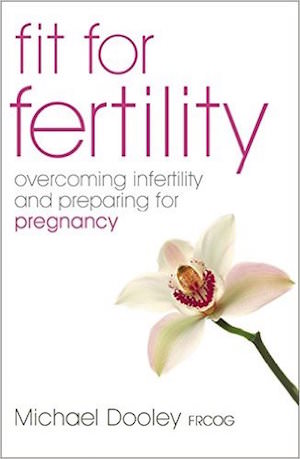
If you are surrounded by family and friends who have conceived easily, it can seem that you are the only couple to suffer from infertility. This book tackles the subject head on, but with a sensitive and practical outlook.
The first section takes the reader to a “back to basics” approach to conception. Of course, we all learnt the basics in biology class at school. However, for some of us, our school days were a while ago, and this revision is welcome! When you learn about conception as a teenager at school it is referred to as something that must be avoided. But Dooley explains to his readers how to go about optimising the conditions for conception to occur.
The second section of the book deals with how to prepare your body for making a baby. This applies equally to men as it does to women, although the book does address the reader as a female on the assumption that more women than men will read it. Dooley goes through the topics of diet, exercise, stress and general fitness. Taking each one in turn, he gives common sense advice and uses examples from his own practice to illustrate how what seem to be minor changes to your day to day practise make to a couple’s chances of conceiving. This part of the process is called getting “fit for fertility” and gives practical tips that are not expensive or unrealistic to put into practice.
Michael Dooley is eminently qualified to advise on this subject, given that he has practised as a fertility specialist for twenty five years. But this is not a purely clinical approach to conception. Dooley has a refreshingly holistic attitude to getting pregnant, and welcomes the responsible use of alternative medicines.
Once Dooley has taken the reader though the lifestyle issues which have a bearing on fertility, he turns to section three of the book, where the time comes to seek medical help. He addresses the matter of when a couple should seek help, and what type of help they should seek. The expression “fertility investigation” might justifiably strike fear in the heart of any couple who are having trouble conceiving. However, in this book Dooley takes the reader through the likely tests the medical professionals might carry out and sets their minds at rest about what to expect.
The final section gets to grips with the question that does through the minds of all couple who are taking longer than they want to conceive: what could be wrong? This part of the book more than any other is essential reading for anyone who has such an appointment booked. So often it can be an overwhelming experience when you consult a doctor about a significant medical issue. But if you read this book in preparation, you will have a basic non-alarmist grounding in all the potential problems.
Most importantly, the “treatments” section does not view IVF as a “magic bullet” as some infertility texts do. Instead, Dooley has a calm discussion about the complex moral and cultural issues involved.
Some pregnancy and conception books are too chatty in their style; others too scientific. This one strikes exactly the right balance in the middle, with a bibliography for those who want further reading and a glossary for those who want further explanation.
